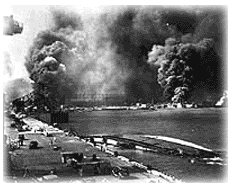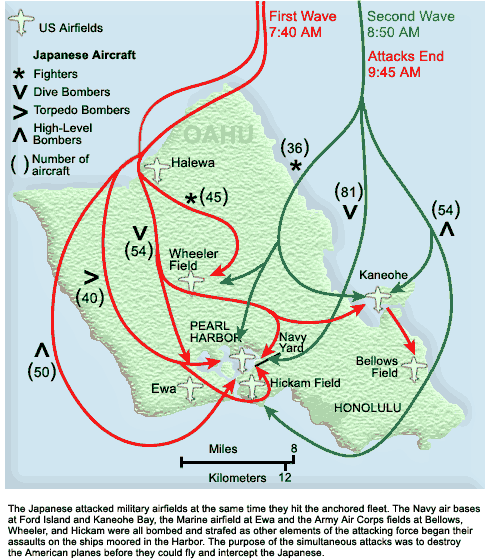Pearl Harbor Naval Base, Hawaii, was attacked by Japanese torpedo and bomber planes on December 7, 1941, at 7:55 a.m. Hawaii time. The sneak attack sparked outrage in the American populace, news media, government and the world. On December 8, President Franklin D. Roosevelt addressed the American Congress, and the nation, to detail the attack. He began:
Yesterday, December 7th, 1941 -- a date which will live in infamy -- the United States of America was suddenly and deliberately attacked by naval and air forces of the Empire of Japan.In that address, the president asked Congress to pass a declaration of war. Congress obliged, voted and passed the U.S. Declaration of War on Japan, on the same day. That was America`s formal entry into World War II.The United States was at peace with that nation and, at the solicitation of Japan, was still in conversation with its government and its emperor looking toward the maintenance of peace in the Pacific.
Indeed, one hour after Japanese air squadrons had commenced bombing in the American island of Oahu, the Japanese ambassador to the United States and his colleague delivered to our Secretary of State a formal reply to a recent American message. And while this reply stated that it seemed useless to continue the existing diplomatic negotiations, it contained no threat or hint of war or of armed attack.
The Pearl Harbor surprise attack has been depicted in many different films over the last 60 years. Michael Bay directed Pearl Harbor in 2001, Fred Zinnermann`s From Here to Eternity was released in 1953, and the popular Tora! Tora! Tora! was made in 1970. And while these films display how destructive and devastating the attack was, they aren`t able to include as much of the historical context because they only have 1-3 hours in which to tell the story.
 The attack took place on a sunny Sunday morning. A minimal contingent of soldiers was on duty at the time. Most offices on the base were closed and many servicemen were on leave for the weekend. New technology, including the new radar mounted on Opana Point, were in place, manned and functioning at the time of the attack. The incoming Japanese attack planes were detected by the radar and reported, but were mistaken for an incoming group of American planes due from the mainland that morning.
The attack took place on a sunny Sunday morning. A minimal contingent of soldiers was on duty at the time. Most offices on the base were closed and many servicemen were on leave for the weekend. New technology, including the new radar mounted on Opana Point, were in place, manned and functioning at the time of the attack. The incoming Japanese attack planes were detected by the radar and reported, but were mistaken for an incoming group of American planes due from the mainland that morning.
While on practice maneuvers outside the harbor that morning, an American destroyer spotted a Japanese submarine attempting to sneak into the harbor. The submarine was fired upon, immediately reported — and ignored.
Pearl Harbor is located on the south coast of Oahu Island. At the time, the naval base was about 22,000 acres in size. The American fleet was under the command of Admiral Husband E. Kimmel and the ground troops were commanded by Lt. General Walter C. Short. Pearl Harbor was the hub of American naval power since King Kalakua gave the right to the U.S. to develop a coal station there in 1887. The harbor had recently been designated as the American Pacific Fleet`s new home base because of concern over Japan`s increasing aggressiveness. Most of America`s military commands of the Pacific Region had headquarters on the base, yet the United States continued its Isolationism.
While there were veiled warnings and isolated events of Japanese hostilities in the weeks, days and hours ahead of the attack, no one in command at Pearl Harbor or in Washington, D.C., expected a Japanese attack on Pearl Harbor, especially before war was formally declared. Effective cryptography and successful cryptanalysis were in their infancy at the time. Under-funded, under-manned and under-equipped, cryptanalysts had been ordered to concentrate on Japanese diplomatic traffic, rather than naval messages. The nation would have had a much clearer picture of the Japanese military buildup and, with the warning provided by those messages, might have prevented the disaster of Pearl Harbor.
Indeed, on the morning of December 7, the Japanese ambassador in Washington, D.C., had been ordered by his government to destroy all official documents and deliver a 14-page document to Secretary of State Cordell Hull at a specific time that day. After laborious manual decoding and translation, the document was delivered later than the Japanese government had intended. The news of the attack on Pearl Harbor had already reached the White House before the Japanese ambassador arrived at the White House. The world was stunned by the news.
Military leaders of the Axis countries, Germany, Italy and Japan, were hell-bent on world domination by military force. Japan needed natural resources, especially oil, for its planned expansion. The Japanese had successfully invaded Manchuria in 1931 and China in 1937. Japan`s antipathy toward America had been seething for a long time. The United States` occupation of the Philippines during the Spanish-American War and America`s refusal to acknowledge Japan`s authority in occupied China fueled Japanese resentment. Imperial Japan`s sphere of interest in the far western Pacific was being threatened by America`s incursions into the Pacific at the very point in history when Japan itself was vying for dominance in the region.
 It is a myth to maintain that strategists of both nations considered Pearl Harbor too shallow, with an average depth of 45 feet, for an attack by torpedoes dropped from airplanes, which usually required about 75 feet of depth. While it seemed improbable, a Hawaiian Chief of Naval Operations memo states that no harbor is to be considered safe from attack. Sabotage by Japanese agents was considered to be the greater threat. The Japanese had developed the technology, attack strategy and skill to successfully accomplish the impossible. The idea to attack Pearl Harbor had been conceived six months before. The American fleet was perceived as an obstacle to access the oil fields in Java, so the plan was conceived to affect a surprise attack on Pearl Harbor to destroy America`s Pacific Fleet. Additional targets included warehouses, docks, airfields and aircraft.
It is a myth to maintain that strategists of both nations considered Pearl Harbor too shallow, with an average depth of 45 feet, for an attack by torpedoes dropped from airplanes, which usually required about 75 feet of depth. While it seemed improbable, a Hawaiian Chief of Naval Operations memo states that no harbor is to be considered safe from attack. Sabotage by Japanese agents was considered to be the greater threat. The Japanese had developed the technology, attack strategy and skill to successfully accomplish the impossible. The idea to attack Pearl Harbor had been conceived six months before. The American fleet was perceived as an obstacle to access the oil fields in Java, so the plan was conceived to affect a surprise attack on Pearl Harbor to destroy America`s Pacific Fleet. Additional targets included warehouses, docks, airfields and aircraft.
The Japanese had developed a shallow running torpedo that would skim the surface of the water in the harbor after being dropped from a low-flying aircraft. The primary targets were the aircraft carriers and battleships that were among 92 naval vessels at anchor in the harbor. With data gathered and reported by Japanese spies on Oahu and Maui, the Japanese admiralty knew the location and quantity of vessels of each type in the harbor. They had two concerns, the loss of surprise and the whereabouts of two missing American aircraft carriers. The carriers Enterprise and Lexington had previously been dispatched to Wake and Midway islands. Both aircraft carriers were hundreds of miles west of the Hawaiian island chain, at the time of the attack.
About 360 Japanese attack planes had launched at dawn from aircraft carriers in an attack force of about 33 ships, under the command of Vice-Admiral Chuichi Nagumo. The strike force had steamed, under the cover of darkness, to about 275 to 200 miles north of Oahu. Once the bombers sighted the island, they split into two groups. One group proceeded overland at low altitude across the island and the other flew over the water around the island to make an approach from the south. At 7:55 a.m., the first bombs and torpedoes were dropped. After two hours, the U.S. sustained 18 ships sunk or severely damaged, about 170 aircraft destroyed, and there were about 3,700 casualties. Japanese casualties were minimal.

Later that day, American ships were attacked on the high seas between San Francisco and Honolulu. Japanese bombers from mainland bases attacked Malaya, Hong Kong, Guam, the Philippine Islands, Wake Island and Midway Island. In the remaining weeks of December 1941, many successive attacks encouraged the Japanese to believe their invincibility.
Several investigations were conducted shortly after the attack. Admiral Kimmel and General Short bore the weight of responsibility imposed by Congress for the extent of the damage caused by the attack. Preparations to defend the base were based upon veiled warnings and vague directives from the White House and the Pentagon. Scouting planes dispatched from Pearl Harbor patrolled the vast ocean expanse around the island chain but had not detected the Japanese fleet heading for the Hawaiian Islands. The early morning radar sightings of the incoming attack force had been misinterpreted. Much of the American fleet was at dock in Pearl Harbor, but not as many key battleships and aircraft carriers were in the harbor as the Japanese had hoped.
Epilogue
What were the Japanese thinking when they concocted their Pearl Harbor plan? Were they not aware that such an act would ignite outrage in the American people and invite retribution? Had the delivery of the 14-page document to Secretary Hull been on time, would it have mitigated the outcome? Japan eventually paid the dearest price for its conduct.
During the weeks and months following the Japanese raid, a great deal of repair work was done by the Pearl Harbor Navy Yard, assisted by tenders and ships` crewmen. Those efforts lasted into February 1942. All but two ships were salvaged. Target ship Utah and the battleship Arizona were not returned to service, and their hulls remain in Pearl Harbor to this day.
All of the foregoing represented one of history`s greatest salvage jobs. Seeing it to completion required that Navy and civilian divers spend about 20,000 hours under water in about 5,000 dives. Long and exhausting efforts were expended in recovering human remains, documents, ammunition and other items from the oil-fouled interiors of ships that had been under water for months. Uncounted hours went into cleaning the ships and otherwise getting them ready for shipyard repair. Much of this work had to be carried out in gas masks, to guard against the ever-present risk of toxic gases, and nearly all of it was extremely dirty.
 Today the battle-scarred, submerged remains of the battleship USS Arizona rest on the silt of Pearl Harbor, just as they settled on December 7, 1941. The ship was one of many casualties from the deadly attack by the Japanese on that day President Roosevelt called "a date which will live in infamy."
Today the battle-scarred, submerged remains of the battleship USS Arizona rest on the silt of Pearl Harbor, just as they settled on December 7, 1941. The ship was one of many casualties from the deadly attack by the Japanese on that day President Roosevelt called "a date which will live in infamy."
Photographs of the Arizona’s burning bridge, listing mast and superstructure in the aftermath of the Japanese attack, and news of her sinking were published worldwide. The photographs symbolized the destruction of the United States Pacific Fleet at Pearl Harbor and the start of a war that was to take many thousands of American lives. Indelibly impressed into the national memory, the image could be recalled by most Americans when they heard the battle cry, "Remember Pearl Harbor."
Following the war, an effort was made to present Pearl Harbor as an avoidable disaster, brought about by FDR`s provocation of Japan and his unwillingness to permit a three-month cooling-off period. Historian Allan Nevins wrote in the New York Times Magazine in December 1945 that the three-month period was regarded by the administration as pointless and that China violently protested the idea. He also commented that:
And what encouragement did Japanese aggressors receive from America? It came in two different ways. It came, first, from men who loudly proclaimed that whatever Japan did in Asia was no affair of ours; that we should concern ourselves with nothing outside our own borders. It came, in the second place, from men who asserted that the United States need never fear any attack from any power whatever; that war with Japan was (as Oswald Garrison Villard wrote) "impossible"; that Japan could never hurt us and we could never hurt Japan.More than a million people visit the USS Arizona Memorial each year. They file quietly through the building and toss flower wreaths and leis into the water. They watch the iridescent slick of oil that still leaks, a drop at a time, from ruptured bunkers after more than 70 years at the bottom of the sea, and they read the names of the dead carved in marble on the memorial`s walls.